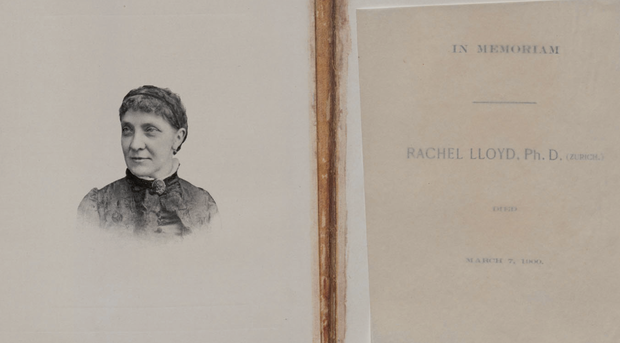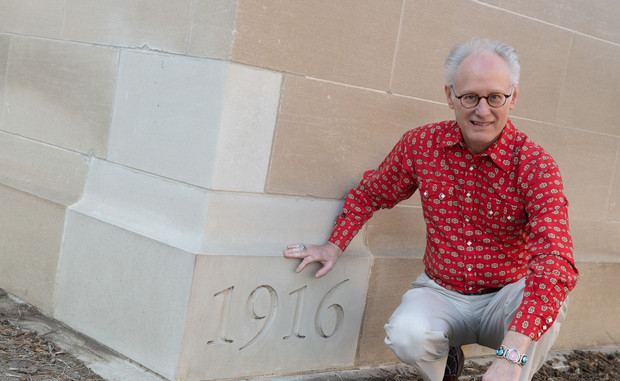Deann Gayman, February 26, 2020
Decades of research brings Rachel Lloyd back to the fore
Rachel Lloyd’s story was largely forgotten for nearly 100 years.
During what Robert E. Knoll heralded as the “Golden Era” of the University of Nebraska–Lincoln in his book, “Prairie University,” Lloyd was a faculty member among giants whose names now dot the campus, and her tenure was relatively short.
But, as Mark Griep has found through two decades of research, Lloyd deserves her own renown for the indelible mark she made on the school as well as the fledgling agriculture of the state. She was the first American woman to earn a doctorate in chemistry, and was instrumental to Nebraska’s early economic growth.
Since first hearing of her role in the department of chemistry during a passing conversation in 1997, Griep has researched and shared Lloyd’s story far and wide, even going so far as to commission the removal of the Avery Hall time capsule in 2014 to unearth historical materials about her. Recently, his efforts to bring Lloyd’s story back in national prominence garnered him a Champion of History award from History Nebraska.
Griep, professor of chemistry, has given more than a dozen talks at conferences, other colleges, on campus and in the Lincoln community sharing Lloyd’s life and work.
“Chemists just love this story, and I think it’s amazing,” he said.
Griep worked for many years to make sure Lloyd received recognition among the American Chemical Society’s National Historic Chemical Landmarks. She received that distinction in October 2014, after Griep was able to open the Avery Hall time capsule. In it was a rare biographical sketch by Lloyd’s brother-in-law, Clement Lloyd, which contained the very thing Griep needed for the ACS recognition — a high-resolution photo of Lloyd.
“Prior to that, the only photo we had was from a university yearbook, ‘The Sombrero,’ in 1895, and it was poor resolution,” Griep said. “The irony of the whole story is that Rachel Lloyd was the faculty chair of the University of Nebraska Photographic Club, and yet she only had that one photo taken. I think she was a modest person.”
The rare manuscript from Clement Lloyd also filled in many of the gaps of Lloyd’s life that Griep didn’t know and illuminated her strength and tenacity even more.

A pioneer in the field
Lloyd was born in Ohio, but eventually moved to Pennsylvania after she lost both her parents before she was a teenager. At 20, she married Franklin Lloyd, who was a chemist. They had two children, but both died in infancy, and Franklin died after just five years of marriage.
“She had a really tragic life,” Griep said. “Whenever I think I have a hard life, I think of her. I found her headstone in Philadelphia, and I saw the names of her children etched on the sides, and it was heartbreaking.”
Lloyd learned chemistry from watching her husband perform experiments in the lab Franklin set up in their home. After his death, when her finances faltered, she taught chemistry at a girls’ school, a women’s college and then a pharmacy school. Lloyd wanted to teach at the co-ed collegiate level, so she took courses through the Harvard Summer School. Unfortunately, no one would hire her without a doctorate, and no school in the United States would confer a doctorate to a woman.
Lloyd attended the University of Zurich, learned German and completed her degree. Then, she was recruited by chemistry department chair Henry Hudson Nicholson to come teach at Nebraska.
She served as a professor of chemistry from 1887 to 1894. She enjoyed a measure of fame during her lifetime and was a frequent subject of news and feature articles in newspapers at the end of the 19th century.
Her work with colleague Nicholson testing the sucrose content in sugar beets grown across Nebraska gave pioneering farmers a new crop that led to an economic boon for the state. Following Lloyd’s research, sugar beet processing factories were built in Grand Island — only the second such factory in the United States — Norfolk and Ames. The Ames factory was eventually moved to Scottsbluff, as sugar beet cultivation moved westward.
Lloyd was also a popular teacher. She and Nicholson oversaw the expansion of the chemistry lab, and set up the Nebraska Agricultural Experiment Station, made possible by the federal Hatch Act. Among her students were Roscoe Pound and Willa Cather. Another student was Samuel Avery, who became a successful chemist and chancellor at Nebraska himself, as well as the namesake of Avery Hall.
“Dr. Lloyd’s work must be more satisfactory to her than anything we can say of it,” Cather wrote for the student newspaper, Hesperian, in 1894. “She has seen develop, largely by her efforts and under her eye, one of the largest chemical laboratories in the West. She has seen her lecture rooms crowded by enthusiastic students of all courses and departments. Where Lloyd may go, she takes with her the gratitude of an institution and of a state where has helped not only to fashion chemists, but to inspire and kindle earnest young men and women to that culture which society needs most.”
Lloyd was eventually appointed chair of the department, until she left the university due to poor health. Griep learned from the biography that she’d had a stroke a year prior to stepping down.
“I learned that it prevented her from using her arm, so she had to retire,” he said. “After that she taught for one year at Hillside Home School in Wisconsin, but then she led a quiet life until she died in 1900.”

Preserving a legacy
Griep has ensured Lloyd’s recognition on campus. Display cases on the second floor of Hamilton Hall now hold materials found in the time capsule. One case has items specific to Lloyd, including the saccharometer she used to test sugar beets.
The high-resolution photo has been disseminated to replace the smudged yearbook photo in Griep’s presentations and in online and print biographical articles.
He also turned Clement Lloyd’s biography over to University Libraries for preservation. The entire manuscript was digitally archived by a team in the Center for Digital Research in the Humanities and is available online.
And he continues to give presentations on her life, including most recently as a Sci Pop Talk on campus Feb. 12.
Griep had the Avery Hall cornerstone replaced with a new time capsule, which includes a slide summary of Griep’s talk about Lloyd’s life and work, along with more than 50 contemporary items from the various departments that have called Avery Hall home.
“I had fun putting it all back together,” Griep said. “There wasn’t much time to assemble everything, and I worked with seven units to include things from most of the departments that have been in Avery Hall at one point or another.
“You can see where the new time capsule went in. The stone is much lighter than the building around it.”





